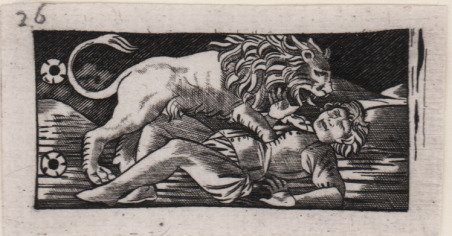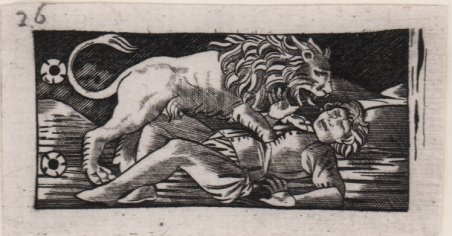Details
Inscription description
TIB 2401.26; Duchesne, p. 246 n. 283; Zanetti, p. 105 n. 146
Description
Copia, di un niello già conservato nella collezione Durazzo (n. 2903), di cui una impressione originale è a Parigi, Collection Dutuit, Musée du Petit Palais. L'impronta originale è marcata distintamente a sinistra da una coppia di fori di chiodi o rivetti al centro di ornamenti a rosetta. È un bell'esempio caratteristico di un artigianato fiorentino del terzo quarto del XV secolo, e fa parte del cosiddetto "gruppo Finiguerra" di stampe a niello. Ma è incerto se sia dello stesso Maso Finiguerra o di un altro niellista fiorentino del periodo. I nielli della collezione Durazzo vennero fatti riprodurre in incisioni dal proprietario, tra fine XVIII e inizio XIX secolo, a Venezia - come specificato anche dal Malaspina nel suo catalogo del 1824 - costituendo una serie che venne diffusa e collezionata dagli amatori. Bartsch descrive queste copie nel suo volume edito nel 1811, data che quindi costituisce il terminus ante quem per l'esecuzione. Copy, of a niello print formerly kept in the Durazzo collection (n. 2903), now in Paris, Collection Dutuit, Musée du Petit Palais. The original impression is distinctively marked at the left by a pair of nail or rivet holes in the center of rosette-like ornaments. It is a fine, characteristic example of a Fiorentine craftsmanship of the third quarter of the fifteenth century, and part of the so-called “Finiguerra group” of niello prints. But whether it is by Maso Finiguerra himself or another Fiorentine niellist of the period is uncertain. It may actually be based on a more elaborate design from the Finiguerra (or Pollaiuolo?) circle, The nielli of the Durazzo collection were reproduced in engravings by the owner himself, between the end of the 18th and the beginning of the 19th century, in Venice - as also specified by Malaspina in his catalog of 1824 - constituting a series that was circulated and collected by amateurs. Bartsch describes these copies in his volume published in 1811, a date that therefore constitutes the terminus ante quem for the execution. ' Cfr. TIB 2401.26; Duchesne, p. 246 n. 283; Zanetti, p. 105 n. 146


Find out how to use
Find out how to use

